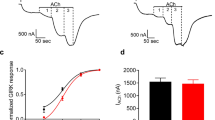Abstract
Acetylcholine, the major excitatory neurotransmitter to the smooth muscle of mammalian intestine1, is known to depolarize smooth muscle cells with an apparent increase in membrane conductance2. However, the ionic mechanisms that are triggered by muscarinic receptor activation and underlie this response are poorly understood, due in part to the technical problems associated with the electrophysiological study of smooth muscle3. The muscarinic action of acetylcholine in certain neurones has been shown to involve the switching off of a resting K+ current (M-current)4 and a similar mechanism has recently also been identified in smooth muscle of amphibian stomach5. We have now applied the patch-clamp technique6 to single smooth muscle cells7,8 of rabbit jejunum and find that muscarinic receptor activation switches on a nonselective, voltage-sensitive inward current. In addition, acetylcholine activates and then suppresses spontaneous K+ current transients, which are probably triggered by rises in intracellular Ca2+ in these cells.
This is a preview of subscription content, access via your institution
Access options
Subscribe to this journal
Receive 51 print issues and online access
$199.00 per year
only $3.90 per issue
Buy this article
- Purchase on Springer Link
- Instant access to full article PDF
Prices may be subject to local taxes which are calculated during checkout
Similar content being viewed by others
References
Bolton, T. B. Br. med. Bull. 5, 275–283 (1979).
Bolton, T. B. J. Physiol., Lond. 220, 647–671 (1972).
Bolton, T. B., Tomita, T. & Vassort, G. in Smooth Muscle: An Assessment of Current Knowledge (eds Bülbring, E. et al.) (Edward Arnold, London.)
Brown, D. A. & Adams, P. R. Nature 283, 673–676 (1980).
Sims, S. M., Singer, J. J. & Walsh, J. V. Soc. Neurosci. Abstr. 9, 732 (1983).
Hamill, O. P., Marty, A., Neher, E., Sakmann, B. & Sigworth, F. Pflügers Arch. ges Physiol. 391, 85–100 (1981).
Benham, C. D. & Bolton, T. B. J. Physiol., Lond. 340, 469–486 (1983).
Benham, C. D., Bolton, T. B. & Lang, R. J. J. Physiol., Lond. 353, 67P (1984).
Mayer, M. L. & Westbrook, G. J. Physiol., Lond. 354, 29–54 (1984).
Nowak, L., Bregestovski, P., Ascher, P., Herbert, A. & Prochiantz, A. Nature 307, 462–465 (1984).
Mayer, M. L., Westbrook, G. & Guthrie, P. B. Nature 309, 261–263 (1984).
Benham, C. D., Bolton, T. B., Lang, R. J. & Takewaki, T. J. Physiol., Lond. (in the press).
Fabiato, A. & Fabiato, F. Circulation Res. 40, 119–129 (1977).
Orchard, C. H., Eisner, D. A. & Allen, D. G. Nature 304, 735–738 (1983).
Brown, D., Constanti, A. & Adams, P. R. Cell Calcium 4, 407–420 (1983).
Katz, B. & Miledi, R. Proc. R. Soc. Lond. B161, 483–495 (1965).
Yellen, G. Nature 296, 357–359 (1982).
Colquhoun, D., Neher, E., Reuter, H. & Stevens, C. F. Nature 294, 752–754 (1981).
Bolton, T. B. Physiol. Rev. 59, 606–718 (1979).
Author information
Authors and Affiliations
Rights and permissions
About this article
Cite this article
Benham, C., Bolton, T. & Lang, R. Acetylcholine activates an inward current in single mammalian smooth muscle cells. Nature 316, 345–347 (1985). https://doi.org/10.1038/316345a0
Received:
Accepted:
Issue Date:
DOI: https://doi.org/10.1038/316345a0
This article is cited by
-
Recent advances in development of devices and probes for sensing and imaging in the brain
Science China Chemistry (2021)
-
Species-Related Differences in the Properties of TRPC4 Channels in Intestinal Myocytes of Rodents
Neurophysiology (2016)
-
Regulation of gastrointestinal motility—insights from smooth muscle biology
Nature Reviews Gastroenterology & Hepatology (2012)
-
Mechanisms of calcium signaling in smooth muscle cells explored with fluorescence confocal imaging
Neurophysiology (2004)
-
Interaction of agonists and selective antagonists with gastric smooth muscle muscarinic receptors
Naunyn-Schmiedeberg's Archives of Pharmacology (2004)
Comments
By submitting a comment you agree to abide by our Terms and Community Guidelines. If you find something abusive or that does not comply with our terms or guidelines please flag it as inappropriate.



